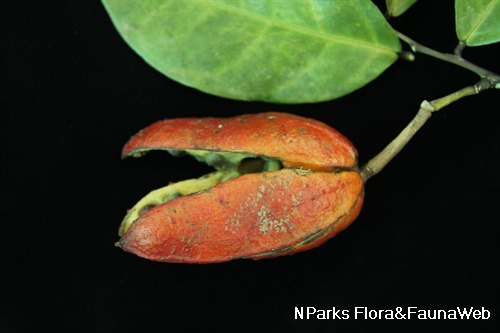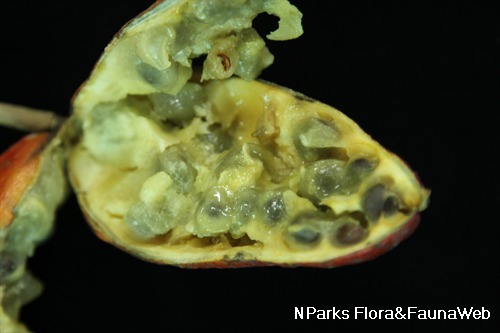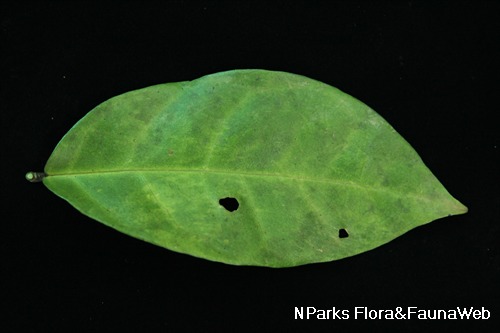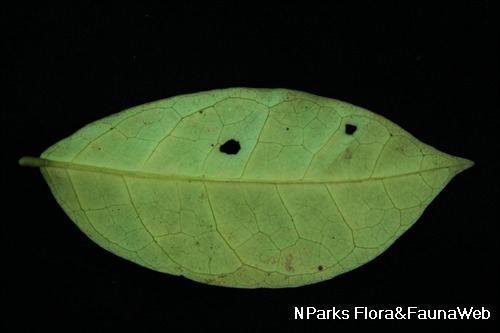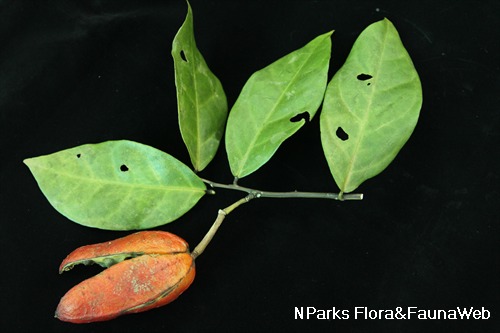
Back
Capparis micracantha subsp. korthalsiana (Miq.) M.Jacobs
| Family Name: | Capparaceae |
| Common Name: | Caper-Thorn, Thorn Caper, Melada, Jambol Merah, Thai Caper Flame Bean, 小刺山柑 |
Name
Classifications and Characteristics
| Plant Division | Angiosperms (Flowering Seed Plants) (Dicotyledon) |
|---|---|
| Plant Growth Form | Tree (Small (6m-15m)), Shrub |
| Lifespan (in Singapore) | Perennial |
| Mode of Nutrition | Autotrophic |
| Plant Shape | Irregular |
| Maximum Height | 10 m |
Biogeography
| Native Distribution | Vietnam, Peninsular Malaysia, Singapore, Borneo, Sumatra |
|---|---|
| Native Habitat | Terrestrial |
| Preferred Climate Zone | Tropical |
| Local Conservation Status | Native to Singapore (Critically Endangered (CR)) |
Description and Ethnobotany
| Growth Form | It is a half-erect shrub or tree with hanging branches up to 10 m tall, with spiny trunk and twigs. |
|---|---|
| Foliage | Its alternate, stalked leaves possess leathery leaf blades that are oblong, occasionally almost lance-shaped, dull yellowish-green when dry, and 6.4–30 by 2.5–13 cm, with blunt or slightly pointed tips. |
| Flowers | Its flowering shoot bears rows of 2–6 white, feathery flowers above the leaf’s axil. Its flowers are also about 2.5 cm long and wide, with much reduced leaves at the end of the twig. The yellow, upper petals turn dull purple, with white tips, while its lateral petals are white. |
| Fruit | Its light yellowish-brown fruits are nearly round, and 3–7 by 3–4.5 cm, with four vertical grooves. They also contain numerous seeds embedded in the orangish-red pulp. Its red to shiny black seeds are smooth, and up to 6–8 by 4–7 cm. |
| Habitat | It grows in evergreen, monsoon or teak forests on dry soil. It also grows in hedges, savannahs, and thickets, below 500 m altitude. It occurs locally in Pulau Ubin. |
| Associated Fauna | Its flowers are insect-pollinated. It is the preferred local food plant for caterpillars of the butterflies chocolate albatross (Appias lyncida vasava), Appias nephele, and Cepora boisduvaliana. It is also the food plant for caterpillars of the striped albatross (Appias libythea olferna), the adult of which lays its eggs singly on a leaf or flower part. |
| Cultivation | It can be propagated by seed. |
| Etymology | Greek Capparis, ancient Greek name for these evergreen shrubs; Greek mikros, small; Greek anthos, flower, referring to the plant’s small flowers |
| Ethnobotanical Uses | Edible Plant Parts : Edible Fruits Food (Herb or Spice) (Fruit or Vegetable): The fruit pulp is sweet but unsafe to eat when unripe. Medicinal: The stem and roots can be used medicinally. |
Landscaping Features
| Landscaping | It is grown in parks as an ornamental tree for its attractive white flowers. |
|---|---|
| Desirable Plant Features | Ornamental Flowers, Ornamental Fruits |
| Landscape Uses | Parks & Gardens, Small Gardens |
Fauna, Pollination and Dispersal
| Fauna Pollination Dispersal Associated Fauna | Butterfly Host Plant (Leaves) |
|---|---|
| Pollination Method(s) | Biotic (Fauna) |
| Seed or Spore Dispersal | Biotic (Fauna) |
Plant Care and Propagation
| Light Preference | Full Sun |
|---|---|
| Water Preference | Moderate Water |
| Plant Growth Rate | Moderate |
| Rootzone Tolerance | Moist Soils, Well-Drained Soils, Fertile Loamy Soils |
| Propagation Method | Seed |
Foliar
| Foliage Retention | Evergreen |
|---|---|
| Mature Foliage Colour(s) | Green |
| Mature Foliage Texture(s) | Leathery |
| Foliar Type | Simple / Unifoliate |
| Foliar Arrangement Along Stem | Alternate |
| Foliar Attachment to Stem | Petiolate |
| Foliar Shape(s) | Non-Palm Foliage (Lanceolate, Oblong) |
| Foliar Venation | Pinnate / Net |
| Foliar Margin | Entire |
| Leaf Area Index (LAI) for Green Plot Ratio | 3.0 (Tree - Intermediate Canopy) |
Floral (Angiosperm)
| Flower & Plant Sexuality | Bisexual Flowers |
| Flower Colour(s) | White |
|---|---|
| Flower Grouping | Cluster / Inflorescence |
| Flower Location | Axillary |
Fruit, Seed and Spore
| Mature Fruit Colour(s) | Brown, Red |
|---|---|
| Fruit Classification | Simple Fruit |
| Fruit Type | Fleshy Fruit , Non-Accessory Fruit |
Image Repository
Others
| Master ID | 1487 |
|---|---|
| Species ID | 2780 |
| Flora Disclaimer | The information in this website has been compiled from reliable sources, such as reference works on medicinal plants. It is not a substitute for medical advice or treatment and NParks does not purport to provide any medical advice. Readers should always consult his/her physician before using or consuming a plant for medicinal purposes. |

